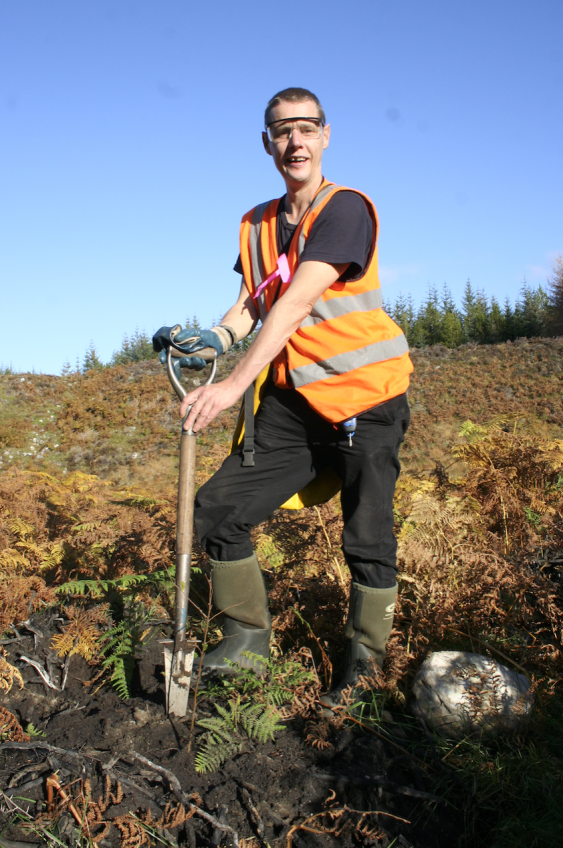Helping Nature make her own Forests
Matt Dalby first became involved with Trees For Life as a volunteer on a Conservation Week in 2009 at Achnashellach. It was such a fantastic experience in the Scottish mountains restoring the beautiful forest, that he has returned year after year and now is a Trees for Life Conservation Week Leader.
 During the first few weeks I heard stories of the early weeks that were held at Athnamulloch Cottage. As someone who loved remote places and living life as simply as possible I was really disappointed that the cottage had been condemned and I had missed the chance to spend a week there, or so I thought.
During the first few weeks I heard stories of the early weeks that were held at Athnamulloch Cottage. As someone who loved remote places and living life as simply as possible I was really disappointed that the cottage had been condemned and I had missed the chance to spend a week there, or so I thought.
In the intervening years I moved from England to Inverness and became more and more involved with Trees For Life as a local Volunteer and later on as a Conservation Week Leader. I also started to explore Glen Affric and began to realise what a magical place it was – to me it became the spiritual heart of the Caledonian Forest and the Trees For Life vision. It was therefore with great excitement that I looked forward to the re-opening of the cottage and the chance to stay there and contribute to the expansion of the forest in such a magical place. After missing out on focalising during the spring season due to health problems I finally got the chance in late May/early June, always a magical time of year with the last of the snow on the mountains and the leaves on the trees vibrant green and fresh after bursting forth with new life not much more than a month earlier, late May still being spring in the heart of the Highlands.
 So it was that 6 of us arrived at the cottage late on Sunday evening to continue with the planting that had been started on the Conservation Weeks. I was expecting a special week, but prepared for an unpleasant week of rain and midges such are the vagaries of the weather in the Highlands. Little did I realise just how magical the week was going to be, the weather was nearly perfect, with low cloud most mornings which generally lifted in a few hours, virtually no rain and enough wind to keep the midges at bay. Most days ended up sunny and the tan improved throughout the week, along with a bit of sunburn.
So it was that 6 of us arrived at the cottage late on Sunday evening to continue with the planting that had been started on the Conservation Weeks. I was expecting a special week, but prepared for an unpleasant week of rain and midges such are the vagaries of the weather in the Highlands. Little did I realise just how magical the week was going to be, the weather was nearly perfect, with low cloud most mornings which generally lifted in a few hours, virtually no rain and enough wind to keep the midges at bay. Most days ended up sunny and the tan improved throughout the week, along with a bit of sunburn.
The walk to the planting site was long, up to an hour and a half, but passed some of the trees that were planted in the early 1990’s, or areas of birch that had naturally regenerated inside the exclosure, depending on the route taken. It was amazing to see how well the trees were doing, there were cones on some of the pines and a few baby pines that had grown from seed produced by trees that were planted by Volunteers all those years ago. To see the second generation of Trees for Life trees was amazing confirmation of the work we are doing, we only need to start off the process and then step back and let nature take over.
We were planting birch on some of the poorer quality soils where species such as pine or hazel would struggle to grow. In time the birch will hopefully draw nutrients from deep down and enrich the soil allowing other species to eventually grow there.
 We were using a technique called hand mounding, which involves digging out a square of soil, putting it back in the hole upside down then planting the tree in the middle of the square. It is a very time consuming process and hard work digging the mound amongst roots and tussocks, but it gives the tree the best chance of getting established by eliminating competing vegetation immediately around the tree. We also added rock phosphate as a fertiliser to further help the trees, this added to the work load as the steepness of the site meant that the fertiliser and the trees had been left a long way from where they were to be planted. This all added to the work, however in such an amazing place and brilliant weather every minute on the hill was a delight, although there were a few aches and pains in the evenings and mornings.
We were using a technique called hand mounding, which involves digging out a square of soil, putting it back in the hole upside down then planting the tree in the middle of the square. It is a very time consuming process and hard work digging the mound amongst roots and tussocks, but it gives the tree the best chance of getting established by eliminating competing vegetation immediately around the tree. We also added rock phosphate as a fertiliser to further help the trees, this added to the work load as the steepness of the site meant that the fertiliser and the trees had been left a long way from where they were to be planted. This all added to the work, however in such an amazing place and brilliant weather every minute on the hill was a delight, although there were a few aches and pains in the evenings and mornings.
One of the most amazing things to see was the number of rowan seedlings on the hillside, while planting a pack of trees in an area of no more than 10 metres square, it wasn’t unusual to see 5 or more naturally regenerated rowans. The seeds had been deposited in bird droppings while the birds were feeding on blueberries which were growing on the hillside. Unfortunately none of the rowans were more than 10cm tall as they had been browsed by deer before the fence was put up. Nature was trying to create a forest, she just needed a bit of help by excluding deer from the area.
By the end of 7 days hard work we had planted about 5,700 trees, which seems like a lot until you looked back, saw the size of the exclosure and realised there should be tens of thousands of trees there. It would be easy to get disheartened by the amount of work that would be involved in planting the whole area. However, I prefer to take the longer term view and think that rather than planting a forest, we created a future seed source that nature can use to create her own forest in time. All we need to do is give nature the chance and the tools to work with, in this case a seed source, and she will complete the job in time.

